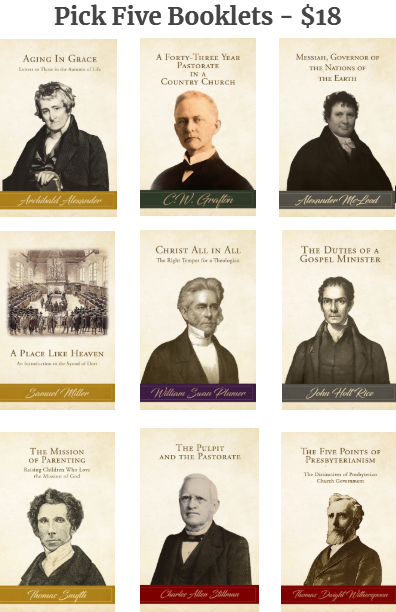(Receive our blog posts in your email by clicking here. If the author links in this post are broken, please visit our Free PDF Library and click on the author’s page directly.)
Reformed Presbyterian minister William Sommerville once wrote that “The Bible does not discourage the slave from making his escape; and the underground railroad is built in the very spirit of God's counsel” (Southern Slavery Not Founded on Scripture Warrant, p. 5). The Underground Railroad — an informal system whereby “agents” and “stations” comprised an avenue of escape for American slaves in bondage — was a tool employed by many in the North to aid slaves seeking freedom, including Presbyterians, and very often, Reformed Presbyterians (Covenanters).
Among the resources found here at Log College Press, there are many perspectives on the slavery issue which were held by 19th century century Presbyterians in various parts of the country. Today’s post focuses on those who were supportive of, active on, or otherwise connected to the Underground Railroad. We highlight a few here in alphabetical order, although more could be mentioned.
Caroline Still Anderson — Caroline was the wife of Matthew Anderson, pastor of the Berean Presbyterian Church of Philadelphia, and daughter of William Still, whose book on the Underground Railroad is a valuable record of material Caroline’s father is sometimes known as “The Father of the Underground Railroad,” and he helped over 800 slaves escape to freedom.
Titus Basfield — Basfield, a former slave, studied at Franklin College, New Athens, Ohio, an institution founded by John Walker, Presbyterian minister and abolitionist, which was a haven for those traveling on the Underground Railroad. A friend and classmate of his, John Bingham, was the principal author of the Fourteenth Amendment to the U.S. Constitution.
Philo Carpenter — Carpenter was a Chicago pharmacist and abolitionist. His home was a station on the Underground Railroad, and it is reported that he helped approximately 200 slaves reach freedom, often by rowing them across Lake Michigan to Canada by night.
Theodore Ledyard Cuyler — Cuyler was an outspoken abolitionist, and it is reported that his Brooklyn, New York congregation — the Lafayette Avenue Presbyterian Church — was a hiding place for escaped slaves seeking freedom.
Alexander Dobbin — Dobbin was a Covenanter who helped found the first Presbytery of the Reformed Presbyterian Church in America, and later, the Associate Reformed Presbyterian Church. He died in 1809, but his house, located at the site of the 1863 Battle of Gettysburg, endured, serving as a waystation along the Underground Railroad.
James Faris — A Covenanter minister from South Carolina, he attempted to have the South Carolina legislature pass a law which would encourage emancipation, but failed. After moving to Bloomington, Indiana, his home became a waystation on the Underground Railroad.
Amos Noe Freeman — Freeman was an African-American Presbyterian minister, who was also a conductor along the Underground Railroad at his congregation in Portland, Maine.
Henry Highland Garnet — Garnet was an African-American Presbyterian minister who was born into slavery, but escaped with the aid of others, including Underground Railroad stationmaster Thomas Garrett.
William Hayes — Hayes was a Covenanter layman who aided slaves in Illinois who were escaping to freedom. He was successfully sued in 1843 by a neighbor, who objected to Hayes’ role in the escape of his slave, Susan “Sukey” Richardson. The well-documented story of that lawsuit and Hayes’ heroic role in the freedom of many slaves is told by Carol Pirtle, Escape Betwixt Two Suns: A True Tale of the Underground Railroad in Illinois (2000).
Erastus Hopkins — Hopkins was a Presbyterian minister who was active politically in the Free-Soil Party. His home in Northampton, Massachusetts has been documented as a waystation along the Underground Railroad.
John Black Johnston — A Covenanter minister, Glasgow reports that Johnston “was a fearless advocate of the cause of the slave, and was a distinguished conductor on the ‘Underground Railroad.”
James W.C. Pennington — Pennington was a “fugitive slave” who escaped by means of the Underground Railroad before later becoming a Presbyterian minister and an outspoken abolitionist.
John Rankin — Rankin was a Presbyterian minister and an active conductor on the Underground Railroad in Ohio. It was Rankin’s account — given to Calvin Stowe — of Eliza Harris’ 1838 escape to freedom that inspired the character Eliza in Harriet Beecher Stowe’s Uncle Tom’s Cabin (see below). It is reported that when “Henry Ward Beecher was asked after the end of the Civil War, ‘Who abolished slavery?,’ he answered, ‘Reverend John Rankin and his sons did.’"
Thomas Smith — Smith was a Covenanter layman who Bloomington, Indiana home was a station on the Underground Railroad.
Calvin & Harriet Beecher Stowe — Calvin was a Presbyterian minister, and his wife Harriet achieved fame with the publication of Uncle Tom’s Cabin (1852), a fictionalized account of a slave who escaped on the Underground Railroad. The Harriet Beecher Stowe House in Brunswick, Maine is officially part of the National Underground Railroad Network to Freedom.
Theodore Sedgwick Wright — Wright was an African-American Presbyterian minister who studied (and suffered — see his 1836 letter to Archibald Alexander) at Princeton. His home in New York City was a waystation for the Underground Railroad.
These connections to the Underground Railroad at Log College Press may serve to whet the appetite for further study of a fascinating and heroic chapter in American history, and shows how passionately some Presbyterians felt about the cause of freedom for those bondage.



